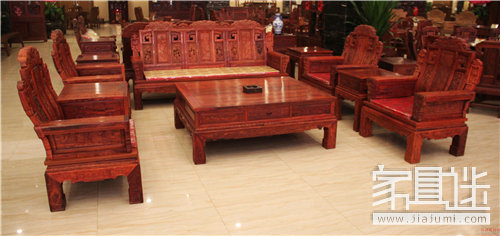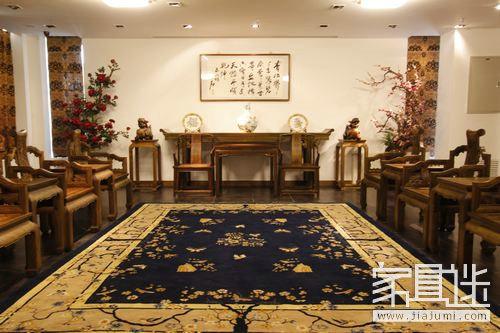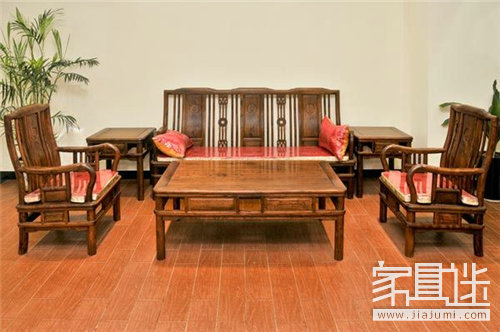Mahogany furniture refers to pieces crafted from rare hardwoods, such as rosewood and other traditional redwoods. It is a general term for high-quality wooden furniture that has been popular since the Ming and Qing dynasties. In the 1980s, demand for mahogany furniture surged, prompting the need for industry regulation. As a result, the state established standards based on density and other characteristics, categorizing certain woods as "two, five, eight, and thirty-three" types. However, in the classical furniture industry, there are many premium hardwoods not included in the national "Redwood" standard. These so-called "leftover materials" still produce exquisite and valuable furniture.
**"Tough Guy" – Small-leaf Red Sandalwood**

*Leaflet red sandalwood furniture*
Although small-leaf red sandalwood is not classified under the national "Redwood" standard, it has gained immense popularity and even surpassed some of the officially recognized redwoods. It is often compared with precious materials like huanghuali, lobular rosewood, red rosewood, and Burmese rosewood. When people first hear the name "small-leaf red sandalwood," they might assume it belongs to the red sandalwood or Dalbergia genus. In reality, its scientific name is *Pterocarpus indicus*, and it is not considered a standard redwood.
Small-leaf red sandalwood is one of the hardest and most durable hardwoods used in furniture making. Its wood is dense, strong, and highly wear-resistant, earning it the title of "tough guy" among woods. The heartwood has a reddish-brown color, with a wavy grain and fine, uniform texture. These qualities make it highly desirable. Due to its similarity in appearance to red rosewood, it has also been misused by unscrupulous sellers to imitate more expensive varieties.
Despite being outside the national standard, small-leaf red sandalwood has attracted significant attention from consumers. Companies like Zhongshan Muyuan Redwood Furniture Co., Ltd. have focused on producing this type of furniture, emphasizing its quality over its classification. As more people recognize its value, non-standard redwoods are gaining market acceptance.
**Related Reading:** Lushi Black Rosewood, Big Leaf Rosewood – Is It Mahogany?
**Emperor’s Wood – Jin Sinan**

*Jin Sina furniture*
According to ancient records, "Golden silk comes from Sichuan, and the wood grain resembles gold." This description refers to Jin Sinan (golden nanmu), a rare and luxurious wood. Its surface displays a golden-yellow pattern due to natural sediments, giving it an elegant, almost metallic appearance. Historically, it was reserved for imperial use, especially for the emperor's throne, symbolizing power and prestige. Ordinary people were forbidden from using it, which earned it the nickname "King’s Wood."
Today, Jin Sinan furniture is more accessible, though it still carries a sense of grandeur. Common items include Arhat beds and palace chairs. Its stable structure and beautiful grain make it a favorite among modern consumers, who can now experience the elegance once reserved for royalty.
**"Pattern Princess" – Brazilian Pear**

*Brazilian rosewood furniture*
Also known as Bahua, Brazilian rosewood is not actually related to rosewood but is instead called "Pear Blossom" due to its unique grain patterns. Scientifically known as *Guibourtia tessmannii*, it is native to tropical Africa and is celebrated for its stunning, ever-changing textures. The wood features wavy, pearl-like, ghostly, and ball-shaped patterns, making it a true "pattern princess."
As a dark and expensive hardwood, Brazilian rosewood is highly valued in the furniture industry. Its beauty and durability make it a popular choice for those seeking both aesthetics and quality. Each piece of furniture made from this wood is like wearing a beautifully patterned coat, drawing admiration from buyers.
In the world of hardwoods, each species has its own charm. While the national "Redwood" standard includes 33 types, many non-standard woods like small-leaf red sandalwood and golden nanmu also hold great value. By utilizing these materials, the industry can address resource shortages while preserving traditional craftsmanship.
**"Scentwood" – African Sandalwood**

*African sandalwood furniture*
When people hear the word "sandalwood," they often think of the aromatic wood used in incense and medicine. However, African sandalwood is quite different. Though it shares the name, it is not the same as true sandalwood. Known as "sandalwood rosewood" in some regions, it is found in East, Southern, and South Africa. Its heartwood is dark brown with black stripes, making it ideal for high-end furniture.
What sets African sandalwood apart is its distinctive fragrance. In Jiangsu, China, it is commonly referred to as "sandalwood" due to its pleasant scent. Furniture made from this wood adds a subtle, refreshing aroma to any room, especially bedrooms.
With the scarcity of traditional redwoods like Siamese rosewood, the furniture industry is turning to alternatives. Although African sandalwood isn't part of the "five genera and eight categories" classification, its color, grain, and texture surpass many standard redwoods. More manufacturers are now exploring its potential, signaling a promising future for this versatile material.
Laptop Handbag,Wenger Backpack,Swissgear Backpack,Ladies Laptop Bag
Ningbo Fineweather International Trade Co., Ltd. , https://www.fwsbag.com